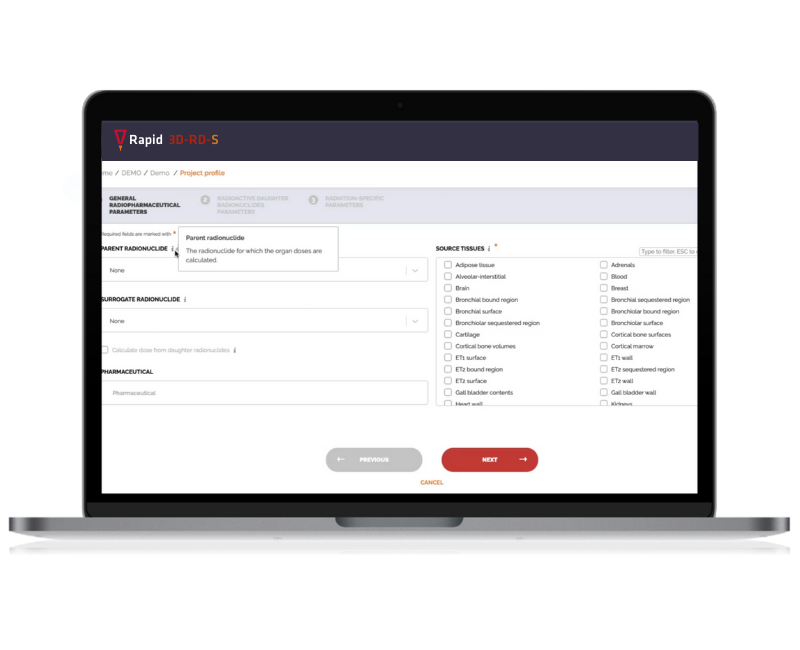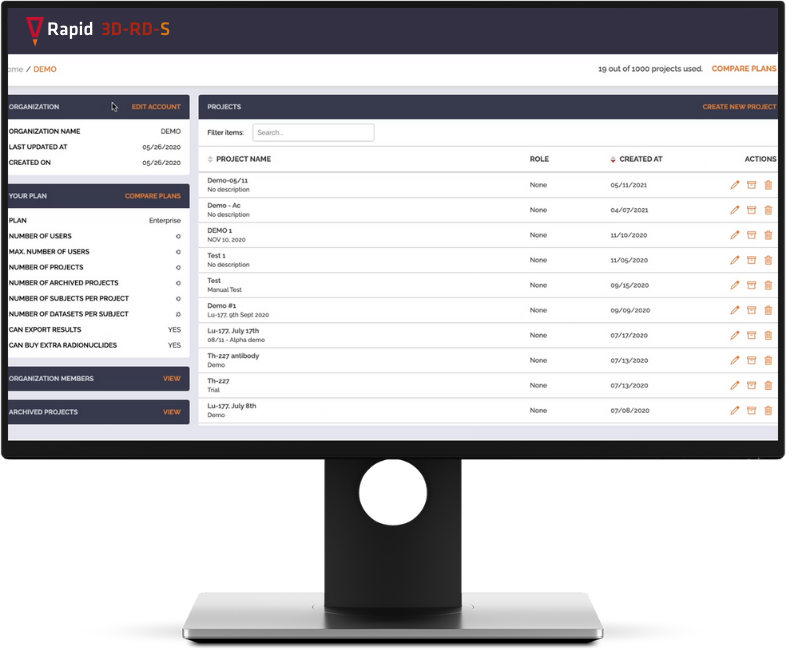3D-RD-S
Rapid’s first SAAS product, 3D-RD-S, is a web-based application used to perform radiopharmaceutical dosimetry. 3D-RD-S is used to calculate an estimate absorbed dose and related radiobiological quantities that translate absorbed doses into likely biological responses.
3D-RD-S

Rapid’s first SAS product, 3D-RD-S is a web-based application used to perform radiopharmaceutical dosimetry using standard phantoms. 3D-RD-S is used to calculate the absorbed dose and related radiobiological quantities that translate absorbed doses into likely biological responses.


3D-RD-S is web-based built for multi-user environments. Organizations can have multiple members with different members having different roles and permissions. This allows each site to define individuals that have view-only access with the ability to comment and users that can perform or modify calculations. Data is organized hierarchically into projects, subjects, and datasets. A project is a collection of subjects whose dose calculations with dose calculations are based on the same radionuclide. A subject is an individual for which a dose calculation was performed. Each subject can have multiple datasets, which contain the input data and results from a dose calculation. The datasets can represent the results for a different set of input data or using different dose calculation methods, e.g., different curve fitting or integration of a time-activity curve.
- Specialize tailored for alpha-particle emitter dosimetry, including flexible accounting for daughter radionuclides and their distribution and incorporation of relative biological effectiveness (RBE) weights.
- Supports the use of surrogate radionuclide PK data.
- Calculates self-dose for tumors of varying sizes and compositions.
- Uses the latest generation of internationally adopted standard phantoms including adult and pediatric male and female phantoms.
- Facilitates multi-site clinical trials involving dosimetry and, eventually, help make dosimetry based RPT administration a routine in cancer treatment not just at large academic medical centers, but at the level of community hospitals.
3D-RD-S Highlights
3D-RD-S is a software-based medical device that uses estimates of the activity (disintegrations of a radioactive nucleus per second) over time to estimate the radiation dose received by internal tissues due to the administration of a radionuclide or environmental exposure.


3D-RD-S Features
- Cloud & Web-based application
- Organizations with multiple users having various roles and permissions
- Ability to export full sets of input and output data in spreadsheet form
- Supports 1,252 radionuclides
- Integrated hierarchical organization of data
- Therapies
- Patients
- Cycles
- Datasets
- Flexible curve fitting and integration models
- Calculates uncertainty of dose values based on uncertainties input data
- Tiered pricing to fit customer needs
- Dedicated expert customer support
Entry
billed annually*Includes 2 active users
-
Host up to 5 users*
-
Up to 5 therapies
- 100 patients/therapy
- 20 cycles/patient
- 20 datasets/cycle -
50 Archived therapies
200 Archived patients/therapy -
Includes all Radionuclides
Available
Scale
billed annually*Includes 10 active users
-
Host up to 20 users*
-
Up to 20 therapies
- 400 patients/therapy
- 80 cycles/patient
- 80 datasets/cycle -
100 Archived therapies
200 Archived patients/therapy -
Includes all Radionuclides
Enterprise
billed annually*Includes 30 active users
-
Host up to 100 Users
-
Up to 1000 therapies
- 5000 patients/therapy
- 400 cycles/patient
- 400 datasets/cycle -
5000 Archived therapies
500 Archived patient/therapy -
Includes all Radionuclides
-
Premium Support
* Additional active users may be purchased within subscription limits at an additional cost
Schedule a 3D-RD-S Demo
Make dosimetry simple. Schedule a demo to see the latest web-based dosimetry platform including, cloud storage, unlimited therapies, users, and 1,252 radionuclides.


Three-Dimensional Radiobiological Dosimetry
Three-dimensional (3-D) image-based internal dosimetry involves using the patient’s own anatomy and spatial distribution of radioactivity over time to obtain absorbed doses. The results of such a 3-D imaging-based calculation can be represented as a 3-D parametric image of absorbed dose, as dose-volume histograms over user-defined regions of interest, or as the mean and range of absorbed doses over such regions.
A: Numeric integration isn’t available when when you have selected to calculate the BED or EQDx. When these are selected, only analytic integration of a fit function is supported. So, the “Apply” button is not available.
In the case of a forgotten password, the user can reset the password by clicking on “Forgot your password?” and following through the steps shown in Figure 3 – 5 below. After clicking on “Forgot your password?”, the user is directed to input their registered email address. The user will then receive a verification code via email to be used to reset the password.
